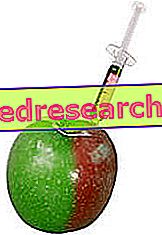Generality
Turnip greens are foods of the vegetable kingdom. These are vegetables (leaves and flowers) that fall within the VI and VII group of foods, as they are rich in vitamin C and vitamin A, as well as fiber and folate.

Description
Turnip greens can be found in different forms, slightly different between the varieties. In general, they are marketed as whole shoots (still joined by the base of the root), as flowers (inflorescence) without leaves and, haimé, also as leaves without flowers. They are green and vary in length between 15 and 100cm (average).
The leaves appear elliptical and jagged, the inflorescences grouped together and more or less globose but always well closed. Stems and stems are more or less thick, turgid and sometimes need to be superficially peeled.
It is always advisable to buy fresh turnip tops; this characteristic is manifested by the overall turgidity of the plant (leaves and stems must not be limp) and with the total closure of the flowers.
Disambiguation of turnip tops
Some readers (mainly from northern Italy) will wonder: " Why have I never come across flowers in buying turnip greens up until now? I've always bought only small bunches of leaves, green and red or green and white! " .
Unfortunately, without having sufficient knowledge to distinguish the various products, it is easy to fall into the deception (or omission) of retailers. These, who perfectly know the different Species and the costs, often put on sale the leaves of the red turnip or of the white turnip with the name of "cime di rapa". In fact, it is a matter of "peaks" and also of "turnip"! Where is the deception? Simple: in common language, turnip greens are the flowers and leaves of a specific plant (Sottospecie sylvestris ) and not the leaves of any other root turnip (Sottospecie rapa ). The latter, although edible, represent a food of little gastronomic value; just think that, until recently, most were destined for animal fodder. In practice, the leaves of the common turnip represent the waste (albeit edible) of the herbaceous Brassica rapa rapa .
To avoid any form of "misunderstanding", I suggest to look for (among the market or supermarket labels) the wording "turnip broccoli"; in the case in which the traditional word "cime di rapa" appeared, it is better to make sure that, in the midst of the tufts, the phantom flowers also emerge. Another useful clue for verification is certainly the origin; despite being a typical product of southern Italy, the vast majority of real turnip tops on the market come from the fields of Lazio.
Notes on cultivation
Turnip greens are autumn-winter vegetables; sowing (or transplanting) is between the last summer months and the first autumn months. Depending on the variety, early turnip greens will become ready after two or three months, while late ones will require an additional 3 or 4 months.
Turnip greens do not need special attention in the crop and it is sufficient to distance the plants to 30cm from each other. The soil and irrigation are more or less the same as root, cabbage, broccoli etc. The most important pest for turnip greens (which, in the case of organic farming, requires protection with special retinas) is the cabbage fly.
Gastronomic applications of turnip tops
Turnip greens are eaten cooked. The respective preparation methods vary essentially according to the product to be obtained, but what unites all the recipes with turnip greens is cleaning and trimming; first of all, it is advisable to wash them thoroughly; secondly they require the elimination (if present) of the root portion adhered to the head and, in the case, of the damaged leaves.
It is possible to distinguish the various procedures on the basis of: raw material and recipe.
- In the case of early and small turnip greens, if you want to boil them: throw only the leaves in boiling water and, after 5 ', even the flowers; past other 5 'drain everything.
- Wanting to cook them by stewing: brown them gently in oil and onion, taking care to use well-uniformed pieces (reducing them or cutting lengthwise stems and stems), then blend with wine, add water and cook slowly with a lid for 30 minutes.
- If, on the other hand, the raw material is made up of large, late turnip greens, in addition to what has been described above, it is necessary to peel off the stems and stems to eliminate the woody outer portion during the cutting and cutting phase.
- The best-known recipes of turnip greens are: Orecchiette with turnip tops (first course), braised turnip tops (side dish), boiled and possibly sautéed turnip tops (side dish), turnip greens and meat.
Turnip greens with chicken sausage
X Problems with video playback? Reload from YouTube Go to Video Page Go to Video Recipes Section Watch the video on youtubeNutritional characteristics
In addition to those of the peaks, we have also chosen to report the values of turnip leaves since, in misunderstanding or not, they represent a large part of the total consumption of Brassica rapa .
As is clear from the tables below, turnip tops and leaves are low-energy foods. Calories are distributed equally between fructose and low biological value proteins and, in addition to being cholesterol-free, contain a good supply of dietary fiber.
It is probable that the potassium content is excellent and the sodium content very low but, in the absence of precise data, we will refrain from considering them as particularly suitable for the diet against hypertension.
Among the mineral salts iron stands out, useful in the treatment of iron-like anemias, but also calcium does not disappoint (especially in the leaves).
As for the vitamins, the leaves are richer in niacin than broccoli, but both foods contain excellent amounts of vit. A (in the form of carotenoids) and vit. C.
Even if not mentioned, both the folates (necessary in large quantities for the diet of the pregnant woman) and the antioxidants with anti-tumor function are present in good concentrations.
The only contraindication to the consumption of turnip greens refers to the considerable content in purines, molecules incorrectly metabolized by those suffering from hyperuricemia and / or gout.
NB . The cooking of turnip greens in water significantly reduces their content in mineral salts (by dilution) and thermolabile vitamins.
Nutritional values
 | |||||
| Turnip broccoli, raw | Turnip leaves | ||||
| Edible part | 60.0% | 63.0% | |||
| water | 91.4g | 92.5g | |||
| Protein | 2.9g | 2.6g | |||
| Prevailing amino acids | - | - | |||
| Limiting amino acid | - | - | |||
| Lipids TOT | 0.3g | 0.1g | |||
| Saturated fatty acids | 0.02mg | 0.03mg | |||
| Monounsaturated fatty acids | 0.24mg | 0.01mg | |||
| Polyunsaturated fatty acids | 0.23mg | 0.04mg | |||
| Cholesterol | 0.0mg | 0.0mg | |||
| TOT Carbohydrates | 2.0g | 2.8g | |||
| Starch | 0.0g | 0.0g | |||
| Soluble sugars | 2.0g | 2.8g | |||
| Dietary fiber | 2.9g | -g | |||
| Soluble fiber | -g | -g | |||
| Insoluble fiber | -g | -g | |||
| Power | 22.0kcal | 22.0kcal | |||
| Sodium | -mg | -mg | |||
| Potassium | -mg | -mg | |||
| Iron | 1.5mg | 2.7mg | |||
| Football | 97.0mg | 169.0mg | |||
| Phosphorus | 69.0mg | 49.0mg | |||
| Thiamine | 0.04mg | 0.08mg | |||
| Riboflavin | 0.16mg | 0.37mg | |||
| Niacin | 1.00mg | 1.80mg | |||
| Vitamin A | 225.0μg | 299.0μg | |||
| C vitamin | 110.0mg | 81.0mg | |||
| Vitamin E | -mg | -mg | |||



